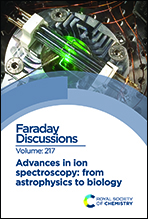Electrospray ionization photoelectron spectroscopy of cryogenic [EDTA·M(ii)]2− complexes (M = Ca, V–Zn): electronic structures and intrinsic redox properties†
Abstract
We report here a systematic photoelectron spectroscopy (PES) and theoretical study of divalent transition metal (TM) EDTA complexes [EDTA·TM(II)]2− (TM = V–Zn), along with the Ca(II) species for comparison. Gaseous TM dianions (TM = Ca, Mn, Co, Ni, Cu and Zn) were successfully generated via electrospray ionization, and their PE spectra, with 157, 193, and 266 nm photons, were obtained at 20 K. The spectrum of each TM complex shows an extra peak at the lowest electron binding energy (eBE), compared to that of [EDTA·Ca(II)]2−. DFT calculations indicate a hexacoordinated metal–EDTA binding motif for all complexes, from which the vertical detachment energies (VDEs) are calculated and these agree well with the experimental values. The calculations further predict negative or very small VDEs for TM(II) = V, Cr, and Fe, providing a rational explanation for why these three dianionic species are not observed in the gas phase. Direct spectral comparison, electron spin density differences, and MO analyses indicate that the least bound electrons are derived from TM d electrons with appreciable ligand contributions, in contrast to [EDTA·Ca(II)]2−, in which the detachment is entirely derived from the ligand. The extent of ligand modulation, i.e. non-innocence of EDTA ligands in the oxidation process, is found to vary across the 3rd row of TMs. Comparing the gas-phase VDEs of [EDTA·TM(II)]2− with the 3rd ionization potentials of TMs and solution phase oxidation potentials reveals intrinsic correlations among these three quantities, with deviations being largely modulated by the ligand participation. The detailed microscopic information about the intrinsic electronic structures and bonding motifs of these complexes obtained in this work will help better understand the rich redox chemistries of these ubiquitous species under diverse environments. The present work, along with our previous studies, indicates that PES coupled with electrospray ionization is a unique ion spectroscopic tool that not only provides intrinsic electronic structure and bonding information about redox species, but also can predict the related electron transfer chemistries with quantitative capability.
![Graphical abstract: Electrospray ionization photoelectron spectroscopy of cryogenic [EDTA·M(ii)]2− complexes (M = Ca, V–Zn): electronic structures and intrinsic redox properties](/en/Image/Get?imageInfo.ImageType=GA&imageInfo.ImageIdentifier.ManuscriptID=C8FD00175H&imageInfo.ImageIdentifier.Year=2019)
- This article is part of the themed collection: Advances in ion spectroscopy - from astrophysics to biology


 Please wait while we load your content...
Please wait while we load your content...
